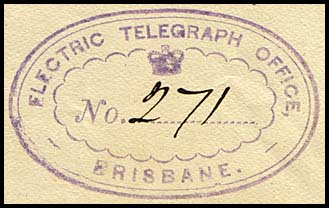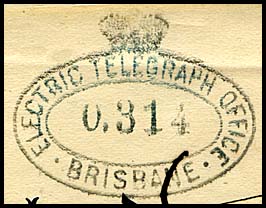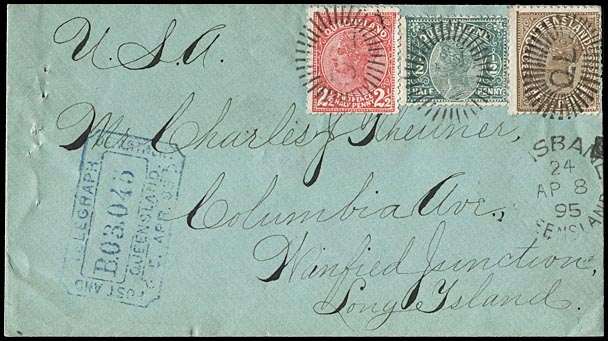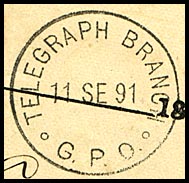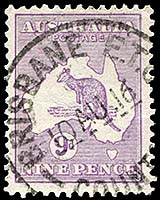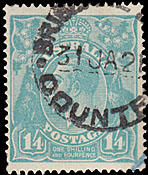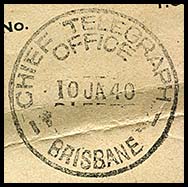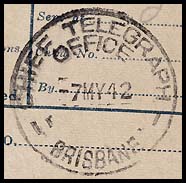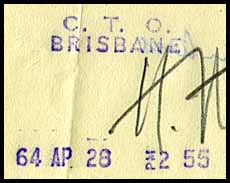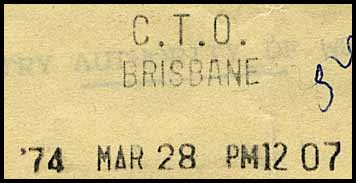Chief Telegraph Office - Brisbane.
- Australia 1901-1988
- New South Wales
- Overview of NSW
- Telegraph lines
- Telegraph Offices
- Date stamps
- Forms
- Envelopes
- Instructional annotation
- Collect
- Delayed
- Free
- Immediate Urgent
- Reply paid
- Rates
- Stamps
- 1871 Telegraph stamps
- 1885 proposal
- 1893 proposal
- Queensland
- South Australia
- Tasmania
- Victoria
- Western Australia
- International
- Special aspects
Details reviewed on this page are:
- Overview of the General Post Office;
- Overview of the Chief Telegraph Office;
- The combined Post and Telegraph Offices;
- Personnel.
- Early usage.
- Date stamps used at the Brisbane Chief Telegraph Office:
Telegraph Office;
Electric Telegraph Office;
Post and Telegraph Department;
Telegraph Branch/GPO;
Brisbane E.T.O/Counter;
Brisbane/TC; - Australian period date stamps:
Telegraph Branch (4 formats);
Telegraph Branch/Counter/G.P.O.
C.T.O. Brisbane/Qld. Aust (1 format);
Chief Telegraph Office (4 formats);
CTO Brisbane straight line format.
- See also the following Slogan Cancellations used at Brisbane:
* Send a Telegram;
* Send Greetings by Telegram;
* Send Birthday Greetings by Telegraph ...;
* Convey Congratulations by Telegraph ...;
* A Telegraphic Code Address ...;
* Other slogans used at Brisbane.
1. General Post Office, Brisbane.
A Post Office was originally established as Moreton Bay by New South Wales in the Moreton Bay District. It was classified as one of the 26 Official Post & Telegraph offices before 1892.
From 1 January, 1850, NSW postage stamps were issued by the Brisbane Post Office and the NSW numeral obliterator 95 was used to cancel stamps. The status of the Post Office was changed to that of a General Post Office in April 1860 as part of the administrative changes required leading to Queensland becoming a Colony independent of New South Wales.
A Female Convict Factory (i.e. a prison) was built in Brisbane in 1828. At some stage, the road on which the prison stood was named Queen Street. An early drawing of the Factory is shown at right. St. Stephen's Church is also shown. In 1837, the Factory was moved to Eagle Farm and the Brisbane gaol was moved to the Queen Street site. Later, the Police Court was located on the Edward Street side. |
 |
In 1872, the use of the site in Queen Street was changed again - a new building was constructed for the General Post Office. Then, in 1876, it was decided to demolish the court house and build a new wing to house the telegraph office. That could be regarded as a first step leading to the merging of the administration of the postal and telegraph services in 1879. The first stage of the building consisted of the central tower and the sections on either side but not including the sections with the lintels at the top. The Telegraph Wing, central archway and clock tower were completed by John Petrie in August 1879 at a cost of £19,000. A report on the new Telegraph Office was given in the Brisbane Courier of 16 August 1879. |
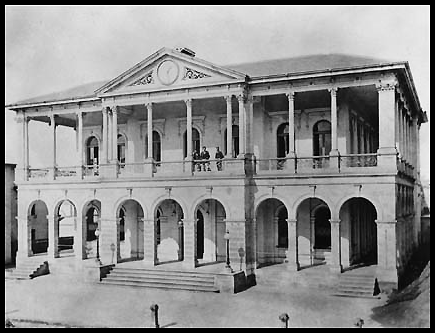 Brisbane GPO - first stage completed. Brisbane GPO - first stage completed.National Archives: J2879-QTH81 |
 |
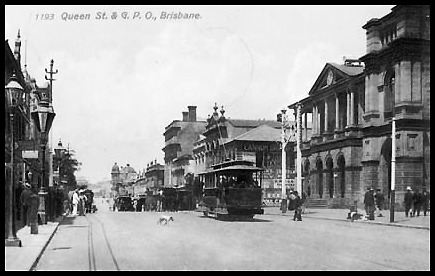 |
| The finished building with a wing added on the right side. The Chief Telegraph Branch was on the right. |
The environs of the new GPO building in Queen Street. The clock overhanging the footpath had not at this stage been installed. The building was built in stages so presumably this view was an early one (circa 1872-75). |
When the first message was transmitted between Brisbane and Ipswich on 12 April 1861 the office "used temporarily in Brisbane was in the upper story of the old Commissariat Store, the inclemency of the weather having delayed the prosecution of the alterations in course of progress at the head station. A visit to the office yesterday was well repaid, as Mr Austin kindly explained the 'modus operandi' of the apparatus and made his visitors thoroughly acquainted with the main principles of the telegraphic system - although they may not have been able, in one inspection, to master all the details" (Moreton Bay Courier 13 April 1861).
The first Chief Telegraph Office - then referred to as the Electric Telegraph Office - was established in 1861 in William Street, Brisbane. The building was referred to as Dr. Lang's Evangelical Church - shown on the left in the picture below-left (the other building is the Government Printing Office). It housed all telegraph staff except for the mechanician and the battery-man who were located a few doors away. Stables were located at the rear for the ponies used to deliver the telegrams. This building was not actually occupied by the telegraph staff until about 21 May because of being refurbished. Until then, a temporary office was set up in the upper story of the old Commissariat Store.
Dr. John Dunmore Lang had been born in Scotland. He is regarded as the father of Australian immigration as well as being a leader in the movement for the creation of Queensland as a separate Colony. His Church was in William Street on the site of what is now the Executive Building. The church was sold to the Queensland Government for £2,000 in December 1860 and it was then refurbished.
 First Queensland Telegraph Office. Source: Australian National Archives - J2879 QTH161. |
 Inside the Queensland Chief Telegraph Office about 1890s. Source: Australian National Archives - J2879, QTH83. |
As telegraphic communication became more popular, the church building became more difficult to use - it had been built for a very different purpose. In his 1876 Report to both Houses of Parliament, Mr. W. J. Cracknell noted as follows:
"The intended new Central Station in Queen Street is in every way urgently required. As stated on former occasions, the present office accommodation is utterly inadequate, whilst an additional motive to promptitude may be found in the fact that much sickness prevailed amongst the staff, which is largely attributable to the unsuitable character, as well as the insufficiency of the building for the number of employees" (p.3).
While still in the old building, the first "Colony of Origin" match took place between seven Chess players from the Telegraph Offices in each Colony:
The Maitland Mercury of 7 January 1872 relates to its readers the gripping details of the Intercolonial Chess Match by Electric Telegraph between New South Wales and Queensland:
"This interesting contest was commenced on Monday (1 January) The players assembled at the Telegraph Office shortly after 10 o'clock, but play did not commence until 11 o'clock. Unfortunately, after a few moves had been telegraphed on each side, the players were informed of the unwelcome news that the line was interrupted and play was not resumed until2:30 pm after which it was continued until 6:00 pm when, according to agreement, the players adjourned for refreshment. They again assembled at the Telegraph Office at 7:30 pm but, owing to a severe thunderstorm at Murrurundi, no further progress could be made with the match. Therefore at 9 o'clock the players dispersed. As regards the probable result of the match, nothing can yet be said ... Mr Adams and Mr Charles Mein kindly acted as the representatives for New South Wales and Mr J. Lippman performed the same office for Queensland. Mr Hunt, of the Telegraph Department rendered able assistance, and the committee are much indebted to Mr P B Walker for his kind courtesy and assistance. We understand play will be resumed on Wednesday night at 7 o'clock".
3. The combined Post and Telegraph Office.
It became clear in the 1870s that a combined Post and Telegraph Office would facilitate the work of both aspects of the Department. As the new Post Office had been constructed in Queen Street, it was deemed appropriate to move the Telegraph Office to that site.
A tender was let to John Petrie in December 1876 for the erection of a new Electric Telegraph Office on the site adjoining the GPO. Eventually, in November 1879, the Telegraph Branch moved from the Church to the Queen Street GPO building.
Again at the rear were 12 stables for the ponies. As telegraphic traffic grew, the Chief Telegraph Office occupied even more space. Further details of a more specific nature are to be found in Gribble (1981, pp.100-107) and Rea (1971).
It was not long however before even this new building was inadequate to meet the demands on the Post and Telegraph Department. Developments for a new building with frontages to Queen Street and Elizabeth Streets were described in the 1900 Report by the Postmaster-General (p. 1-2).
A Report from the Brisbane Courier describing the interior of the new Telegraph Office is accessible elsewhere.
The previous building in Queen Street - together with two other historical buildings for the Chief Secretary and the 1828 Commissariat Officers quarters and a special weeping fig tree - were demolished in August 1899 to enable construction of a new building for the Lands Department.
|
The staff of the Electric Telegraph Office at that time of opening consisted of Mr. J. J. Austin (Superintendent), R. O. Bourne (accountant), Walter Baskill (station master) and operators George Hamilton, James Hobbs, J. Cotts J. Bourne, Welaby and O'Connor. There were only four instruments in the head office at the time. Mr. J. J. Austin was appointed to the position of General Superintendent of Telegraphs but he died in April 1862. "He had been in a delicate state of health for some time and, within a few days before his death, exhibited symptoms of general decline and a breaking-up of his system". |
 Mr. Cracknell and his staff in 1869. |
Mr. W. J. Cracknell, who had been appointed as the Station Master at Ipswich, was appointed Superintendent after Mr. Austin.
From May 1861, the Electric Telegraph Offices were open for public business, daily (Sundays excepted) from 9 a.m. to 5 p.m. On Thursday evening in each week, the offices in Brisbane and Ipswich would re-open from 8 to 8.30 p.m. |
|
The earliest indications of the operation of the Brisbane Telegraph Office are:
|
|
6. Date stamps used at the Brisbane Telegraph Office - various names.
| Telegraph/Office/ Brisbane. The first hand stamp made for the Brisbane Telegraph Office. A remarkable survivor - only three recorded examples but only one on a form. |
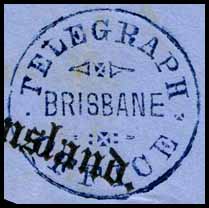 Used on a delivery form on 19 September 1866 (QC-DO-2). Diameter: 30 mm. Provenance: Dave Elsmore. |
| Telegraph Branch/ G.P.O. One line date stamp, 2 digit year.
|
 8 April 1882. Used on QC-DO-7A. |
Used on QC-DO-7A (ii). |
 27 January 1911. Used on QI-DO-1B. |
 9 May 1911. Used on QI-DU-1. |
 9 July 1906. Corinphila Besaçon Collection, May 2018, Lot 3197. |
||
|
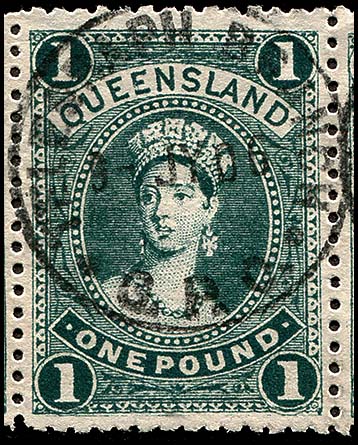 9 July 1906. |
|
| Telegraph Branch/ Queensland.
Two letter month. Four digit year.
|
 19 March 1915. Used on QI-DO-1C. |
 21 April 1915. |
| Telegraph Branch/ Brisbane. Two letter month. Two digit year.
|
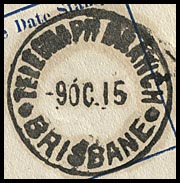 9 October 1915. Used on QI-DO-1C. |
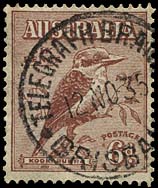 12 November 1935. |
Telegraph Branch G.P.O./ Queensland. Two Formats. Has dots on either side of Queensland. Not described elsewhere.
|
 22 April 1912. Earliest recorded date. Has uneven dots around Queensland on the outside and no stop after the O of G.P.O. Used: 22 April 1912 to 29 November 1917 (AE-DU-1). Diameter: 25 mm. |
 3 January 1933. Latest recorded date. Has even dots around Queensland centered on the letters and a full stop after the O of G.P.O. Used between 18 August 1929 and 3 January 1933. Diameter: 29 mm. |
| Telegraph Branch/ Bris - Aust. Long date line.
|
 17 January 1961 (LRD). Archival date stamp. |
Telegraph Branch C.T.O./ Qld - Aust.
|
Long date line. |
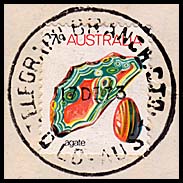 17 December 1973. Short date line. Archival date stamp. |
| Telegraph Branch/ Counter G.P.O. The TB/C date stamp was soon replaced by the BRISBANE/TC (Telegraph Counter) date stamp (see below). Has a small rhombus between G.P.O. and COUNTER.
|
 1 July 1902. |
 5 July 1902. |
 1 September 1902. |
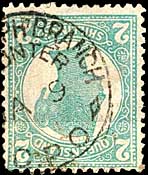 9 January ?? |
| Brisbane/T.C.
Two early date stamps for use on telegrams are known for Brisbane. Both have the letters T.C. (Telegraph Counter) at the base. They appear to have been used between 1895 and 1914 (at least). See Scudder (2013) and Campbell (1990). |
||
| Type 1: Two line date with time between the lines. Full stop after C.
|
 24 May 1904. Copied from Campbell p. 153. |
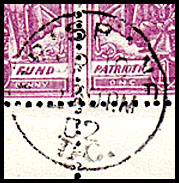 10 September 1902. Used on the 1900 Patrotic Fund 1d CTO block (see charitystamps australia.com) . |
| Type 2: One line date with time included and the letters of BRISBANE are close together. No full stop after C.
|
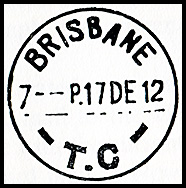 17 December 1912. Copied from Campbell p. 153. |
|
|
 28 August 1911. |
Chief Telegraph/ OFFICE moved from the right side to under the top two words -
|
|
|
| Chief Telegraph Office/ Brisbane. Diameter: 30 mm. Long date. |
 13 December 1934. Diameter: Letters are more rounded.
Know used from 19 June 1933 to |
 13 June 1955. 1 mm square dots. Known used from 9 March 1949 to 14 April 1960. |
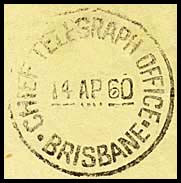 14 April 1960. 1 mm square dots. Known used from 9 March 1949 to 14 April 1960. |
| Type 3: BRISBANE- QLD at base. |
|||
| Type 4: QLD (.) at base. |
|||
| Type 5: QLD - AUST at base. Diameter: 31 mm.
|
| C.T.O. Brisbane. Qld-Aust. Diameter: 31 mm. Large date line. |
.jpg) 10 January 1940. Thin lettering. Archival date stamp. |
 5 November 1945. Thicker letters. Used on AW-DO-10 (43). |
.jpg) 12 March 1952. Letters of CTO are unevenly spaced - the gap between C & T is wider than the gap between T & O. Archival date stamp |
Small date line.
|
.jpg) C.T.O. BRISBANE. QLD AUST at base. 12 February 1953. Archival date stamp (smaller date - type 5 (iv). |
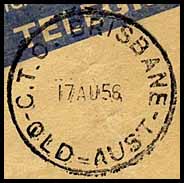 C.T.O. BRISBANE. QLD - AUST at base. 17 August 1956. Longer arcs in front and between words at base. Used on AA-DO-13A. |
Unusually used in violet. Used on Congratulations form AW-GC-54B for a message from Brisbane Sub(urb) to Women's Intermediate Hospital, Brisbane. |
The types reference the Cowan and Dell classification of postal date stamps.



